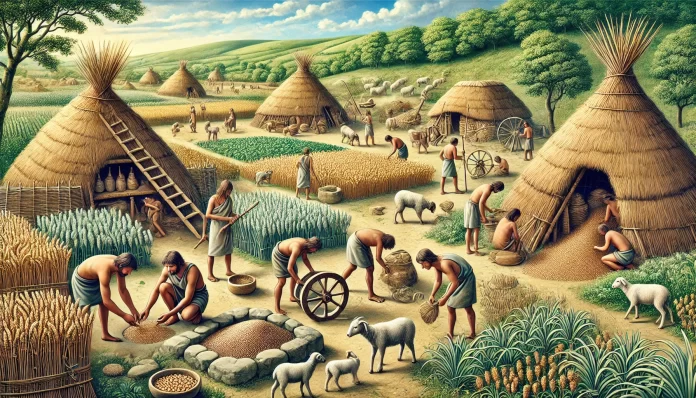Chapter 4: Plants and People
As the flowering plants flourished, Earth’s ecosystems became more diverse and abundant, laying the foundation for the emergence of humanity. From the beginning, humans and plants have been intertwined in a shared history of survival, adaptation, and innovation. Plants provided the essentials for life—food, shelter, medicine—and shaped the course of human civilization in profound ways.
Early Human Interactions with Plants
Long before the advent of agriculture, early humans relied on wild plants for sustenance. Fruits, nuts, seeds, roots, and leaves were gathered from their natural habitats, forming the primary diet of hunter-gatherer societies. Plants were more than just food—they also provided materials for tools, clothing, and shelter.
Some of the earliest evidence of human reliance on plants dates back hundreds of thousands of years:
- Stone tools were used to grind seeds and tubers.
- Firewood from trees enabled cooking and warmth.
- Early medicinal plants, such as wild herbs, were likely discovered through trial and error, forming the basis of traditional medicine.
The Agricultural Revolution (10,000 BCE)
Around 10,000 years ago, humans began to domesticate plants, marking the start of the Agricultural Revolution. This pivotal shift from foraging to farming changed the course of human history. In fertile regions like the Fertile Crescent, the Yangtze River Valley, and Mesoamerica, people began to cultivate plants, selecting those with desirable traits.
Key early crops included:
- Wheat and barley in the Middle East.
- Rice in Asia.
- Maize (corn) in the Americas.
- Potatoes and cassava in South America.
- Millet and sorghum in Africa.
Domestication transformed wild plants into more productive and reliable food sources. Seeds became larger, fruit sweeter, and plants easier to harvest. This surplus of food allowed human populations to grow and settle in one place, leading to the rise of villages, cities, and eventually civilizations.
Plants as Medicine
Throughout history, humans have relied on plants for healing. Ancient cultures around the world identified the medicinal properties of herbs, bark, roots, and flowers. Some early uses of plants in medicine include:
- Willow bark, the source of aspirin, used by ancient Egyptians and Greeks for pain relief.
- Garlic, used for its antibacterial properties.
- Opium poppy, cultivated in Mesopotamia for pain relief and anesthesia.
- Tea leaves, first used in China for their calming and digestive benefits.
Traditional medicine systems, such as Ayurveda and Traditional Chinese Medicine, were built on the knowledge of plants and their healing properties.
Plants and Human Culture
Plants became symbols of life, death, and renewal, deeply embedded in human mythology, religion, and art. Sacred plants like the lotus in Egypt and India, the olive in the Mediterranean, and maize in Mesoamerica were revered as gifts from the gods.
From dye plants like indigo to fibers like flax and cotton, plants became integral to cultural expression, shaping clothing, trade, and economies.
The Industrial Revolution and Beyond
The rise of industry brought new uses for plants, as humans harnessed their chemical compounds for everything from fuel to medicine.
- Rubber trees (Hevea brasiliensis) fueled transportation with rubber tires.
- Cotton became the backbone of the textile industry.
- Sugarcane drove global trade and shaped entire economies.
- Quinine, from the cinchona tree, helped combat malaria, opening tropical regions for settlement.
The Industrial Revolution also saw the beginning of widespread deforestation, monoculture farming, and the exploitation of plant resources, foreshadowing modern environmental challenges.
Plants in the Anthropocene
Today, humans shape plant life on a global scale. From genetically modified crops to reforestation projects, we influence the evolution and distribution of plants like never before. Yet, this relationship remains a delicate balance. Habitat destruction, climate change, and pollution threaten the very plants we depend on.
The Bond Endures
Our journey with plants is far from over. As we face the challenges of the modern world, plants continue to sustain and inspire us. From feeding billions to combating climate change through carbon sequestration, plants are at the heart of our survival and future.
The story of plants and humans is a partnership—one built over millennia, rooted in mutual dependence, and blooming with endless possibilities.
The next chapter focuses on the modern role of plants in ecology, technology, and culture




